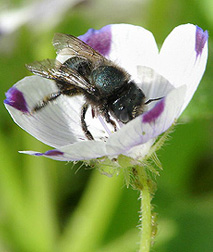This page has been archived and is being provided for reference purposes only. The page is no longer being updated, and therefore, links on the page may be invalid.
| Read the magazine story to find out more. |
|
|
Bee Pastures May Help Pollinators Prosper
By Marcia WoodAugust 4, 2010
Beautiful wildflowers might someday be planted in "bee pastures," floral havens created as an efficient, practical, environmentally friendly, and economically sound way to produce successive generations of healthy young bees.
The pesticide-free pastures could be simple to establish, and—at perhaps only a half-acre each—easy to tend, according to U.S. Department of Agriculture (USDA) entomologist James H. Cane. He's based at the Pollinating Insects Biology, Management, and Systematics Research Unit operated by USDA's Agricultural Research Service (ARS) in Logan, Utah. ARS is USDA's principal intramural scientific research agency.
Bee pasturing isn't a new idea. But studies by Cane and his collaborators, conducted in a research greenhouse and at outdoor sites in Utah and California, are likely the most extensive to date.
Two bee businesses are already using the findings to propagate more bees.
The research indicates that species of pastured pollinators could include, for example, the blue orchard bee, Osmia lignaria. This gentle bee helps with pollination tasks handled primarily by the nation's premier pollinator, the European honey bee, Apis mellifera. Cane estimates that, under good conditions, blue orchard bee populations could increase by as much as four- to fivefold a year in a well-designed, well-managed bee pasture.
Cane and colleagues have studied wildflowers that might be ideal for planting at bee pastures in California. In particular, the team was interested in early-flowering annuals that could help bolster populations of blue orchard bees needed to pollinate California's vast almond orchards.
The research, funded by ARS and the Modesto-based Almond Board of California, resulted in a first-ever list of five top-choice, bee-friendly wildflowers for tomorrow's bee pastures in almond-growing regions. These pasture-perfect native California plants are: Chinese houses (Collinsia heterophylla), California five-spot (Nemophila maculata), baby blue eyes (N. menziesii), lacy or tansy phacelia (Phacelia tanacetifolia), and California bluebell (P. campanularia).
Cane has presented results of his research to almond growers at workshops.
Read more about the research in the August 2010 issue of Agricultural Research magazine.
This pollinator research supports the USDA priority of promoting international food security.

